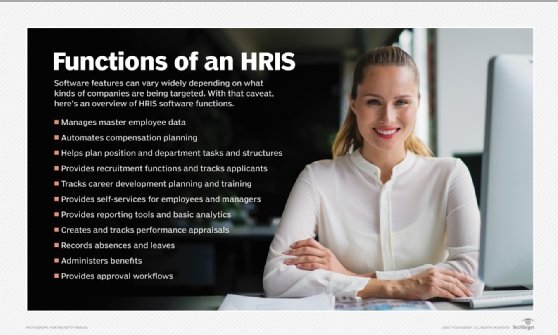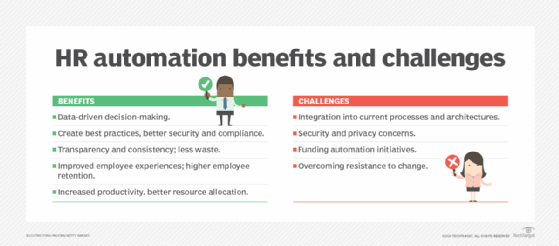What is HRIS (human resources information system)?
A human resources information system (HRIS) is software that aids organizations in maintaining detailed employee information and managing and automating core human resources (core HR) processes.
HRIS as an employee database
An HRIS provides a centralized repository of employee primary data that the human resources management (HRM) team needs to complete core HR tasks.
HRIS software stores, processes and manages employee data, including the following:
- Names.
- Addresses.
- National IDs (non-U.S.) or Social Security numbers.
- Date of hire.
- Visa or work permit information (in the case of international hires).
- Compensation.
- Benefits selected (health insurance, dental, vision, etc.).
- Information about dependents.
Some HRIS platforms also store information such as time and attendance, job history, training and development, and performance reviews.
HRIS software typically also provides HR functions, such as recruiting, applicant tracking, time and attendance management, performance appraisals and benefits administration. An HRIS can also offer employee self-service and accounting functions.
HRIS functions
As an HR tool, an HRIS usually features modules to handle the following tasks:
- Core HR.
- Primary data management.
- Organizational management, such as positions and departments.
- Employee and manager self-services.
- Absence and leave management.
- Benefits administration.
- Workflows.
- Performance management.
- Recruiting and applicant tracking.
- Compensation management.
- Training tracking that may complement a learning management system (LMS) and organizational development.
- Reporting and basic analytics.
- Payroll.
- Onboarding.
HRIS provides a comprehensive set of functionalities to serve most HR needs. Without an HRIS, data might be stored in unsecured or paper-based documents or spreadsheets. Manual data entry can cause errors, and manual cross-checking of documents and spreadsheets can be time-consuming and often confusing, especially with a lack of standardization on how data is captured and stored.
Even when a specific system is purchased to cover a process -- such as benefits administration -- it might require manually entering employee data changes to keep the system up to date. If multiple systems are used, data reentry could be required for each system, or users might need to export data from one system, change it and then import it into another system.
In some instances, payroll might be part of an HRIS. However, many vendors either don't include payroll as part of their HRIS offering or -- as with companies such as Oracle, Workday and SAP SuccessFactors -- they sell payroll as a separate system that integrates with their HRIS.

The importance of HRIS
HRIS is important to organizations and HR departments because it efficiently maintains and manages detailed employee information. In some ways, an HRIS can be considered a "smart" employee information database. The interaction of the data, the processes that can be performed, and the reporting capabilities make the data stored in the system more accessible and usable. This data enables HR teams to maintain accurate employee records and to generate useful reports that could inform HR and organizational decision-making.
The information stored in the HRIS also facilitates seamless and efficient interactions between organizations and their employees, thus helping to create a more employee-friendly culture.
HRIS with self-service functionality enables employees to take responsibility for their own information. They can independently access or update the information as needed, without involving or waiting for HR personnel. For example, they can check their benefits or leave accrual, or update their contact details on their own. This not only provides convenience for employees but also simplifies information management for HR teams.
HRIS information also enables companies to better know their employees. Companies can use the knowledge and insights generated by the HRIS to connect with employees in meaningful and personalized ways to help workers discover the right training programs, devise career development plans and identify areas for improvement in their workplace performance.
Through digitization and automation, HRIS eliminates -- or reduces -- the need for paper-based and manual HR processes. It provides a centralized repository to maintain and update HR policies and procedures, enabling HR departments to automate, streamline and standardize many HR admin tasks, minimizing the potential for delays in processing requests and inaccuracies.
A related benefit of HRIS is that it reduces the administrative burden for HR staff. By automating and streamlining many standard HR processes, the HRIS allows the staff to focus on performing more strategic and high-value work where their uniquely human skills can be applied best.
HRIS also facilitates accurate record-keeping and reporting. These reports facilitate more informed, data-driven decision-making and enhance operational consistency and org-wide accountability.
HRIS can also play a critical role in enabling compliance. For example, regulatory data, such as U.S. equal employment opportunity information or U.K. Working Time opt-out, can be stored, allowing organizations to gain insight into the workforce.
HRIS can serve a critical role in enabling other HR systems to access employee data. Systems such as payroll and learning management systems require this data to offer HR services to employees. The HRIS facilitates this access by integrating with these systems. Integrating HRIS with other applications also creates greater HR efficiencies and reduces the need for data entry into multiple systems, thus minimizing the potential for costly errors that might hamper employee engagement.

HRIS benefits
HRIS software can breathe new life into a company's HR processes and procedures. While the benefits vary depending on the system a company opts for or the modules it chooses, the following are key benefits of HRIS software:
- Expedites tasks. An HRIS enables the HR department to spend less time on time-consuming, repetitive or tedious administrative tasks, helps ensure the accuracy of employee data and makes it easier for employees to manage their information.
- Reduces paperwork. Having a centralized repository for employee data removes the need to store paper files, reduces physical storage requirements, and makes searching for and finding information much easier. Digitization also reduces the costs involved in purchasing and managing physical materials like paper, file folders and cabinets.
- Simplifies predictive analysis and visualizations. Most HRIS software can generate various reports, provide ad hoc reporting capabilities and offer HR analytics on important metrics such as head count and turnover. Modern HRIS software also offers data visualization capabilities for employee information, such as automatically rendering organizational charts or nine-box grid employee assessment tools. Decision-makers in HR and senior management can use these reports and visualizations to gain actionable insights into the workforce and take appropriate actions to address gaps.
- Empowers employees. Employees can directly access and make changes to their personal information without contacting HR.
- Improves productivity. Self-service features simplify the process of making changes to employee primary data or organizational data, making it less time-consuming than paper-based requests. Approval workflows enable changes to be approved or rejected, with the necessary individuals automatically notified. An HRIS might also offer mobile capabilities that extend self-service and provide additional flexibility for remote workers.
- Maintains compliance. HR tasks are highly regulated, and there's little margin for error, particularly from a regulatory compliance perspective. Many HRIS programs have monitoring capabilities and are designed with specific compliance regulations in mind. The most reliable HRIS products also automatically keep track of changing regulations. This helps organizations to stay compliant and avoid the negative consequences of non-compliance, such as legal issues, penalties, financial losses and reputational damage.
- Offers security and privacy. Data security and privacy are important factors when handling sensitive personal information. When using paper forms or spreadsheets, information can easily be accessed by people who aren't authorized. This can result in serious data breaches and associated problems like reputational damage or regulatory fines. An HRIS includes multilayered security and privacy controls to secure employee data and keep it private.
- Provides scalability. A cloud-based HRIS is easily scalable depending on an organization's needs. As a company grows, the HRIS can be scaled up or down so it can continue to provide the benefits of employee data management and core HR standardization with minimal disruption to HR workflows.
- Offers data-driven features to support organizational decision-making. Some HRIS software includes features such as predictive analytics, forecasting and modeling, which can aid HR and company leadership in making informed decisions based on actual data. They can also create forecasts and models about future staffing needs to better prepare for changes and ensure that a talent pipeline is in place to help the organization meet its goals and objectives.
HRIS challenges
Well-designed HRIS software can bring many benefits to organizations and their HR functions. However, it also presents some challenges. Organizations need to be aware of these challenges to make the best use of the HRIS they implement. Some of the challenges include the following:
- Selection difficulties. Some companies can struggle to select the "right" HRIS. To help with selection decisions, it's important to first analyze the organization's needs, pain points and challenges that the HRIS is expected to address or ameliorate. It's also important to ensure that the product aligns with the business goals by not getting distracted by components or modules that are not required or particularly useful.
- Usage difficulties. Modern HRIS tools are often complex, multifeatured behemoths that can overwhelm many HR teams. It's important to provide appropriate training and documentation to all users before they can start using the system. This can flatten the learning curve and minimize the potential for incorrect usage.
- Data privacy. As a repository of sensitive data, the HRIS must include controls to secure the data and protect it from leaks and breaches. The best HRIS products provide multi-layered data security through measures like role-based access controls (RBAC), data encryption, strong password requirements and multifactor authentication (MFA).
- Regulatory compliance. The HRIS must also align with regulatory requirements regarding data security and privacy. Organizations must choose HRIS software that remains compliant with regulations, even if the regulations change. Non-compliant HRIS can make the business vulnerable to costly regulatory fines and legal issues.
- Resistance to change. Implementing an HRIS can meet with resistance from the HR team and also from the general employee population. To minimize resistance, decision-makers should clearly communicate the benefits of HRIS before making costly investments.
Types of HRIS software
HRIS software is typically separated into multiple categories, such as the following:
- Comprehensive HRIS. These software tools act as a centralized database for data that supports operational and tactical HR processes.
- Limited function. These applications focus on one or two core HR processes, such as payroll, benefits management or learning management.
- Operational HRIS. This software category will assist HR and managers with talent management needs, such as hiring, promotions and other personnel-related processes. Operational HRIS software focuses on making existing systems more efficient.
- Strategic HRIS. Strategic HRIS tools aid human capital management (HCM) processes for analysis, decision-making and goal setting.
- Tactical HRIS. This category focuses on compliance, efficiency, recruitment, training and other internal workforce management processes.
A variety of HRIS software is available and aimed at different sizes of organizations, ranging from small and medium-sized businesses all the way up to large enterprises. Usually, the difference is in the range and depth of features for each process area. While most HRIS software covers a large portion of the processes described above, many systems aimed at midmarket enterprises have less depth of functionality in each feature than those aimed at large enterprises.
Cloud-based HRIS
A cloud-based HRIS is delivered via the Internet and can be accessed by authorized users. These systems are designed to be intuitive and user-friendly so that both HR personnel and employees can easily access and use them.
Some cloud HRIS systems allow system admins to customize user experiences. Such customizations may not be possible with on-premises systems. At the same time, cloud-based systems provide the same functionalities as on-prem products to streamline many core HR processes and ease employee data management. Employee self-service features are almost always included in cloud HRIS. Employees can log into the HRIS from a web browser or mobile app to access their personal information, download documents and issue time-off or other requests.
Most cloud-based HRIS are scalable, so they can grow with an organization. With their flexible architecture, they can deal with new employees, vendors, geographies, contracts and the associated growing volumes without breaking their core functionalities. Also, they can be integrated with other HR systems to provide greater functionality for HR processes and workflows.
Almost all cloud-native HRIS products include compliance features. These systems help to ensure that HR activities are aligned with compliance requirements and laws, including labor, immigration and employee safety laws.
Finally, advanced cloud-based HRIS software includes AI capabilities. AI algorithms and machine learning (ML) models analyze vast volumes of data and generate actionable, real-time insights that enable HR teams to upgrade their HR practices related to recruitment, talent management, learning and development, and more. Senior leaders can also use these insights to make more informed decisions to boost employee engagement and retention.
Cloud-based HRIS products are usually provided as monthly or yearly subscriptions. The pricing is usually based on a flat-rate model or a per-employee per-month (PEPM) plan. The price will likely vary depending on factors like the number of users, features, storage, integrations and customizations. Some providers also provide on-premises and hybrid cloud options. These are usually available on-site using a perpetual licensing model, with additional fees incurred for the vendor to provide ongoing maintenance.
The difference between an HRIS and an HRMS
Exact definitions of HRIS and human resources management system (HRMS) vary, but many experts believe that HRMSes offer greater functionality by adding talent management and HCM options to human resource information systems.
The talent management functions often include the following:
- Employee onboarding processes.
- Succession planning.
- Career development planning.
- Learning management.
The HCM functions often include:
- Labor tracking, typically as a system that tracks all necessary work and distributes that work to workers, often in hourly roles, such as in manufacturing plants.
- Time entry and evaluation.
- Workforce management.
Comparing HRIS vs. HRMS vs. HCM vs. HXM
HRIS is commonly used with similar terms such as HRMS, HCM and HXM. Although they might be used interchangeably colloquially, these terms have subtle differences.
- HRMS. An HRMS is a set of software applications that HR professionals use to manage HR functions. It refers to more overarching software that uses HRIS but also features more complex functionalities involved in talent management.
- HCM. Human capital management is a comprehensive set of practices and tools used for recruiting, managing and developing employees. HCM also refers to a category of software organizations use to automate recruitment, management and workforce development. HCM software application suites enable HR teams to handle numerous HCM functions, including recruiting and performance management.
- HXM. Human experience management (HXM) is a process that focuses on collecting and analyzing data related to the employee experience. The goal of HXM is to improve the overall employee experience. HXM software focuses on linking core HR, payroll, talent management and people analytics processes.
In general, HRIS refers to technology that stores employee data and automates core HR functions. It thus acts as a centralized database for employee information. HCM software includes features to streamline employee-centric processes, such as talent management, time tracking, and labor management. HRMS products include HRIS functions and HCM features to streamline payroll, talent management, analytics and more. HXM refers explicitly to software used to manage employee experience.
HCM is both a set of HR processes and the name of a software category. HRMS, in contrast, is a set of integrated software applications and other technologies used to manage HR processes. HRMS is nearly synonymous with the less commonly used HRIS. HRIS, however, can mean just the core administrative system.
Core HR technology systems have long been marketed under HRIS and HRMS labels, but HCM has recently begun to displace both terms.
Key considerations when choosing an HRIS
Investing in an HRIS is a massive undertaking for any organization. Before selecting software, organizations should involve the appropriate stakeholders and thoroughly assess current and future needs. While HRIS selection isn't a linear process, the following are some general steps that an organization should consider before adopting an HRIS:
- Initial assessment. This step identifies an organization's biggest pain points and challenges with current HR processes. The organization should determine who will participate in the HRIS selection process and whether it will be conducted internally. Smaller businesses with limited staff and resources might consider hiring consultants.
- Collect internal data. Conduct an internal audit of the features and functionalities necessary for the company's HRIS software. This can be accomplished by interviewing employees, managers and stakeholders, and observing day-to-day operations. Employee input is essential, as it helps make adopting the new HRIS easier. For example, a company with a large group of telecommuters or employees who travel regularly might give feedback to replace the time-clock-based system with an online timekeeping system. A time clock-based system makes more sense in a manufacturing environment, as employees perform all work on-site.
- Create a checklist. After the internal evaluation, a checklist should be developed, noting all the determined requirements. This checklist should be updated regularly as the company goes through various research phases.
- Assess the budgetary limitations. The project's budget can be determined once the list of requirements has been finalized. This can be achieved by performing a budgeting exercise, which investigates budgeting and technological and time constraints that the company might potentially face. HRIS vendors can also assist in narrowing down company costs and budgets. Cost assessments can be broken down into software, hardware, implementation and support. For example, hardware costs aren't a factor if the company goes with a cloud-based HRIS, whereas the software will typically be priced as a monthly subscription.
- Select a vendor. Create a vendor checklist and evaluate HRIS vendors against the organization's needs and requirements to create a shortlist of potential vendors. After all the insights from the initial and internal assessments are gathered, companies can prepare a request for proposal. Once a vendor is selected, the company can decide whether to go with a basic package and add more modules and functionalities as the business scales or start with a comprehensive package.
HRIS vendors
Numerous companies provide feature-rich HRIS software. Below is an unranked sample list of HRIS providers:
- SAP SuccessFactors.
- Gusto.
- Rippling.
- BambooHR.
- FactoHR.
- Workday.
- Namely.
- Optimum.
- Zenefits.
Some HRIS platforms are well-suited for mid-size companies, including products from the following:
- BambooHR.
- Rippling.
- Gusto.
- Paycor.
- ADP.
Some of the mentioned below can also support the HRIS needs of smaller firms:
- SAP SuccessFactors.
- BambooHR.
- UltiPro.
- Zenefits.
Future of HRIS technology
HRIS technology is constantly evolving. While automated HRIS isn't new, the features and functionalities of the systems are expected to become more efficient and useful to cater to the growing trend of remote work and globalization. When employees work in different locations, departments and specializations, having an HRIS in place is essential.
Evolving trends with HRIS technology include:
- Artificial intelligence and machine learning. As automated technologies advance, the future of HRIS will likely feature the integration of AI and ML to help users make intuitive decisions. These intelligent systems will be able to detect what employees want to accomplish, such as changing benefits selection or requesting time off. This will also enable AI- and ML-based HRIS products to offer proactive solutions, such as using AI-powered cloud technologies for pay calculation and time tracking. AI-based facial recognition could eliminate the need for passwords, ID badges or waiting in line to sign in to work.
- Performance management. HRIS products are introducing comprehensive performance management features that can completely change how employee performance is tracked, rated and communicated. Many organizations have been slow to adapt to the changing HR trends. However, as HRIS technology becomes more advanced, these organizations will be able to adopt new performance management programs to give them more options for performance reviews.
- Compliance and regulations. Companies can avoid compliance violations and penalties by moving away from complicated payroll and seeking access to automated compliance. Future HRIS platforms will provide automated compliance to enable companies to keep up with complex and evolving compliance laws.
- Software as a service. On-premises HR systems or SaaS options are being widely adopted, making it easier for organizations to access HR information from anywhere. This trend will likely expand in the next few years and play an important role in how workplaces and employees function collectively.
- Advanced integrations of HR systems. Payroll and HRMS both play important but separate roles. For most organizations, payroll typically maintains corresponding pay and time data, whereas HRMS stores all employee data. Modern HRIS programs provide advanced integrations, which prevent the disruption of a business's current ecosystems by integrating these complementary systems into one platform. This way, businesses can connect pay and time with employee data and use these factors to manage performance, engagement and productivity. Cloud-based HRIS tools also play an important role in sending data to both local and global systems within payroll and HR.
- Predictive analytics for workforce planning. The predictive analytics provided by some HRIS tools let HR professionals make more data-driven decisions. For example, an HRIS can predict attrition rates by analyzing real-time data and historical data.
- Employee self-service. Current HRIS tools provide employees with self-service portals, letting employees access their personal information or perform tasks such as managing benefits or requesting vacation time.
What do HRIS analysts do?
In general, HRIS analysts ensure efficient organization and presentation of information concerning all features of HR functions within a company. HRIS analysts are highly trained HR professionals with skills in both IT and HR, who are responsible for managing and maintaining the HRIS and presenting relevant and beneficial data on employee productivity, attendance, training and pay.
HRIS analysts also ensure that IT departments adhere to HR regulations, provide necessary resources to employees and arrange for appropriate system updates and upgrades.
Some of the other responsibilities of HRIS analysts might include the following:
- Translate business requirements and user needs into clear technical requirements.
- Design, implement and maintain the HRIS.
- Troubleshoot HRIS issues.
- Offer technical support to HR users and other employees.
- Evaluate the HRIS to identify areas of improvement and make recommendations.
- Implement or add measures to strengthen data quality, security and privacy.
- Provide reports and insights to senior leaders to assist with decision-making.
Large organizations might employ several HRIS analysts to focus on specific HR tasks, such as employee benefits, compensation or training.
HRIS analysts can be valuable additions to an organization's HR department. They can provide these specific benefits:
- Customer service for both the employee and management users of the HRIS.
- Advice based on analysis of HRIS processes and outcomes.
- Data entry for the large amounts of employee information.
- Assurance that employee information and data are kept confidential and secure.
- Increased accuracy due to the analyst's editing and confirming of data before it's reported.
Most companies hire HRIS analysts who have at least a bachelor's degree in information technology, human resources or business administration. Familiarity with major HRIS software is almost always mandatory, while experience with IT project management, data analytics and system development lifecycle is considered a plus. Additionally, HRIS analysts with strong communication and problem-solving skills, critical thinking skills and attention to detail are more likely to be considered for hiring.
Many companies don't require their HRIS analysts to be certified by a recognized institution. However, to be competitive in the job market, ensure career progression and increase their salary potential, it's suggested that they provide proof of their excellence in the field and commitment to HR by obtaining certifications from accredited and globally-recognized entities, such as the International Association for Human Resource Information Management (IHRIM).
In 2025, the average base salary for an HRIS analyst in the U.S. is $83,101, according to Glassdoor. Experienced HRIS analysts can earn as much as $119,810 per year. Salaries tend to be higher in large cities like New York, Los Angeles, Denver and Seattle. Actual salaries for HRIS analysts depend on many factors, including the number of years of experience, location and education level.
To help you whittle down your HR software shortlist, learn the pros and cons of some top HR software vendors and tools, and get buying tips to ensure your purchase is a success.







